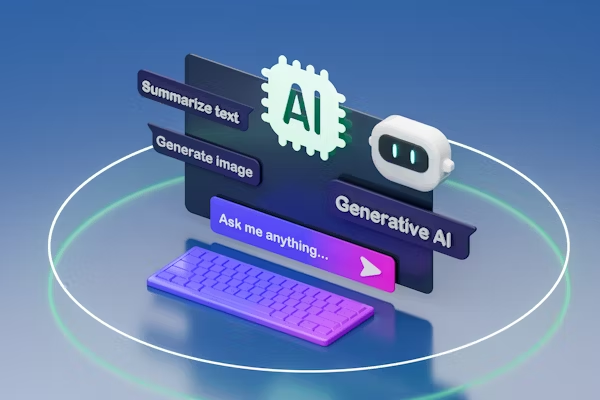
As we move further into the digital era, one of the most transformative forces reshaping the marketing landscape is generative artificial intelligence (AI). Leveraging machine learning models like GPT-4, DALL•E, and other generative tools, businesses can now create everything from written content and videos to personalized emails and campaign strategies at unprecedented scale and speed. This article delves deep into the opportunities and challenges of using generative AI in marketing, providing insights into its current capabilities, real-world applications, and future potential.
What Is Generative AI?
Generative AI refers to algorithms that can create new content based on existing data. Unlike traditional AI, which analyzes and predicts, generative AI produces outputs such as text, images, videos, music, or even code. These models rely heavily on deep learning techniques, especially transformer-based architectures, to understand context, syntax, and semantics.
Examples of Generative AI Tools in Marketing:
- ChatGPT (OpenAI): Text content generation and conversational marketing.
- DALL•E (OpenAI): Image generation based on prompts.
- Jasper AI: AI copywriting for emails, blogs, and ads.
- Synthesia: AI video creation for product explainers and ads.
- Runway ML: Video editing and creative media tools powered by AI.
These tools are being increasingly integrated into the daily workflows of marketers, helping to enhance creativity, reduce production time, and lower costs. Many businesses now choose to hire SEO experts to fully leverage these tools, maximise productivity, and boost their overall marketing performance.
Opportunities of Generative AI in Marketing
1. Automated Content Creation
Generative AI can produce blog posts, product descriptions, email campaigns, and social media content, helping marketers scale faster than ever.
Table: Traditional vs AI-Generated Content
| Feature | Traditional Content Creation | Generative AI Content Creation |
| Speed | Slow | Instant |
| Scalability | Limited | High |
| Human Effort Required | High | Low to Medium |
| Cost | Expensive | More cost-effective |
| Consistency | Variable | Consistent |
2. Hyper-Personalization
Using generative AI, brands can create personalized content at scale based on user behavior, location, and preferences. AI-powered platforms can draft dynamic email campaigns with tailored subject lines and product recommendations. Personalization is no longer limited to names and demographics, AI allows real-time content changes based on user actions and engagement history.
3. AI-Powered Visual Content
With tools like DALL•E and Midjourney, marketers can generate custom visuals for ads, blog posts, and social media without needing graphic design skills. These platforms can interpret complex prompts and deliver compelling visuals that align with a brand’s aesthetic. This visual innovation enables faster turnaround for ad creatives, landing page elements, and social campaigns.
4. Enhanced Customer Engagement
Chatbots powered by generative models (like GPT-4) can handle customer queries in natural language, providing 24/7 engagement and improving the customer journey. These bots not only provide answers but also understand user sentiment, offering more empathetic responses. For e-commerce, these bots can serve as shopping assistants, product advisors, and troubleshooting agents.
5. Creative Experimentation
Generative AI allows marketers to A/B test variations of headlines, calls to action, email formats, and ad creatives in real-time, identifying what resonates most with their audience. This rapid experimentation accelerates decision-making and enables brands to remain agile in an increasingly complex and evolving market.
6. Speed to Market
Generative AI accelerates campaign development, allowing brands to respond instantly to market trends, news events, or viral conversations. By reducing dependencies on large creative teams or agencies, smaller businesses can compete more effectively with established brands.
7. Real-Time Localization
Marketers targeting international audiences can utilize generative AI for real-time content translation and cultural localization. Tools such as DeepL and Google’s PaLM models help generate marketing messages tailored to specific linguistic and cultural contexts.
Key Applications Across Marketing Channels
Content Marketing
- AI-generated blogs with SEO optimization.
- Automated pillar and cluster content creation.
- Real-time newsjacking using AI to generate timely content.
Email Marketing
- AI-personalized email flows based on customer segmentation.
- Predictive send times and subject line generation.
- AI-powered spam and deliverability optimization.
Social Media Marketing
- AI-generated video clips, carousels, and captions.
- Hashtag optimization and trend forecasting.
- Sentiment-aware AI for real-time crisis response.
Advertising
- Automated ad copy and headline testing.
- Dynamic visual ads generation using image AI.
- AI-powered bidding optimization for paid ad campaigns.
E-commerce
- AI-powered product descriptions.
- Dynamic visual merchandising.
- Conversational AI for pre-sale assistance.
Influencer & Affiliate Marketing
- AI-generated scripts and captions for influencer campaigns.
- Affiliate performance forecasting.
- AI analysis of influencer ROI and alignment.
Challenges and Risks of Generative AI in Marketing
1. Quality Control & Brand Voice
AI can produce grammatically correct text, but it may lack brand personality, emotional nuance, or contextual relevance.
Example:
AI-generated text might say, “Buy now for a great deal!” when your brand voice prefers something more sophisticated, such as “Elevate your experience with exclusive access.”
2. Ethical and Legal Concerns
Using generative AI raises questions about authorship, copyright, deep fakes, misinformation, and content ownership. Brands must be cautious not to infringe on intellectual property when generating visuals or mimicking real voices for ads.
3. SEO and Content Saturation
Mass production of AI-generated content could lead to a flood of low-value content, potentially penalized by search engines. Google’s algorithms are evolving to detect content that lacks originality or E-E-A-T (Experience, Expertise, Authoritativeness, Trustworthiness).
4. Bias and Inaccuracy
Generative models can reflect the biases in their training data and produce incorrect or offensive outputs. This risk can harm brand reputation if not properly managed. It’s crucial to implement safeguards like ethical AI filters and bias monitoring tools.
5. Over-Reliance and Creativity Loss
Excessive reliance on AI could reduce human creativity and innovation in campaigns. AI should augment—not replace—strategic thinking and emotional intelligence in marketing.
Table: Risks of Using Generative AI in Marketing
| Risk Category | Example | Impact |
| Content Accuracy | AI fabricates a product feature | Misinformation/legal risk |
| Copyright Infringement | Generated image resembles copyrighted work | Legal action |
| Bias | AI generates gender-stereotypical ad copy | Reputation damage |
| Brand Consistency | Copy deviates from established tone | Loss of brand trust |
| Data Privacy | AI model leaks sensitive customer info | Regulatory fines |
Case Studies
Case 1: Coca-Cola’s AI Marketing Campaign
Coca-Cola launched the “Create Real Magic” campaign, inviting artists to generate branded artwork using DALL•E and GPT. It created significant buzz while showcasing the creative potential of AI.
Case 2: HubSpot AI Content Assistant
HubSpot embedded generative AI into its CRM to help marketers draft emails, blogs, and landing pages within their workflow. This streamlined marketing operations and sped up production.
Case 3: Sephora Virtual Assistant
Sephora utilizes conversational AI to recommend beauty products and address skincare queries, enhancing customer satisfaction and conversion rates.
Case 4: Grammarly’s Tone Detection & Rewrite
Grammarly’s AI helps marketers rewrite content based on tone and audience preferences, preserving brand voice and clarity at scale.
Case 5: Unilever AI Copy Lab
Unilever’s in-house “AI Copy Lab” uses GPT models to generate ad variations for testing, drastically reducing time-to-market.
Future Outlook: What Comes Next?
1. Integration with Real-Time Data
Next-generation generative models will incorporate live customer and market data to produce contextually relevant content on demand.
2. Multimodal AI Models
The evolution from text-only models to multimodal ones (text, image, audio, video) will open up new marketing opportunities, such as:
- Auto-generated explainer videos.
- Personalized podcasts.
- Interactive voice experiences.
3. Human + AI Collaboration
The future is not about AI replacing marketers but enhancing their capabilities. Tools like Copilot or AI writing assistants will act as creative partners. This collaboration will blur the line between human intuition and machine intelligence.
4. AI Regulation and Guidelines
Expect growing calls for transparency in AI-generated content, including clear labels, established ethical standards, and robust compliance policies.
5. Embedded AI in Marketing Tools
Expect native integration of generative AI into platforms like HubSpot, Mailchimp, and Salesforce, making AI usage seamless and intuitive.
6. Responsible AI Frameworks
Brands and agencies will develop internal AI guidelines for usage, accountability, data privacy, and brand safety to prevent misuse and ensure transparency.
Best Practices for Using Generative AI in Marketing
Always Human-Edit Content
Utilize AI to draft, but refine the outputs to align with your brand’s tone, message, and standards.
Use High-Quality Prompts
Garbage in, garbage out. Train your team to craft structured, high-quality prompts for better results.
Test and Monitor Outputs
Continuously A/B test and track performance metrics. Don’t blindly trust AI outputs.
Disclose and Stay Transparent
If AI is used in content creation, consider disclosing it to build trust.
Stay Compliant
Regularly audit AI content for legal compliance, inclusivity, and factual accuracy.
Use Ethical Boundaries
Avoid generating fake reviews, testimonials, or deepfakes for marketing gain.
Conclusion
Generative AI is fundamentally changing how marketers create, deliver, and optimize content. From accelerating creative workflows to enabling unprecedented levels of personalization, it opens new doors for innovation and scale. However, it also brings serious challenges related to quality, ethics, and over-reliance. By understanding its capabilities and limitations, marketers can strategically leverage generative AI to drive smarter, faster, and more impactful campaigns.
Ultimately, those who combine AI’s efficiency with human creativity and ethical oversight will lead the next frontier of digital marketing. The future of marketing is not AI or human it’s AI with human.


